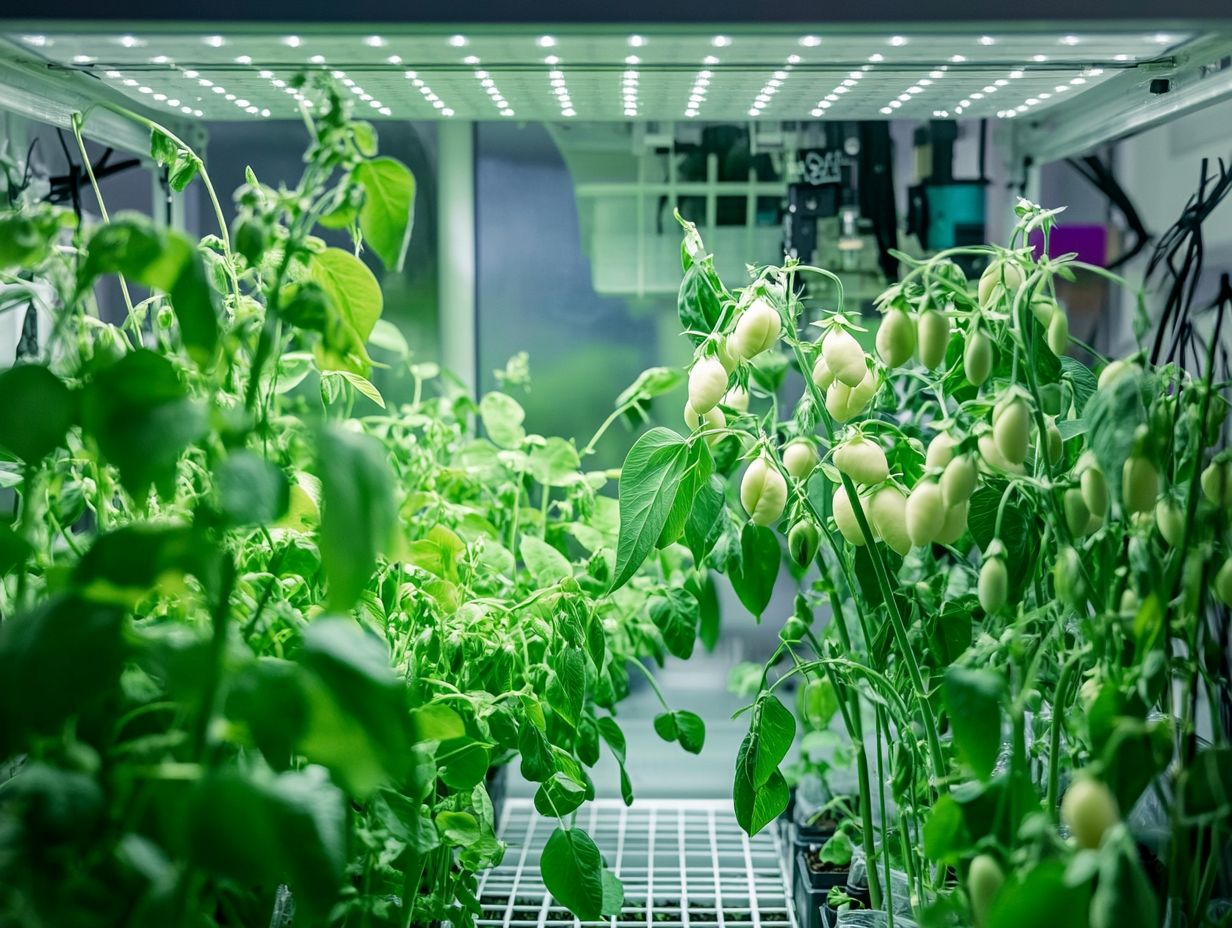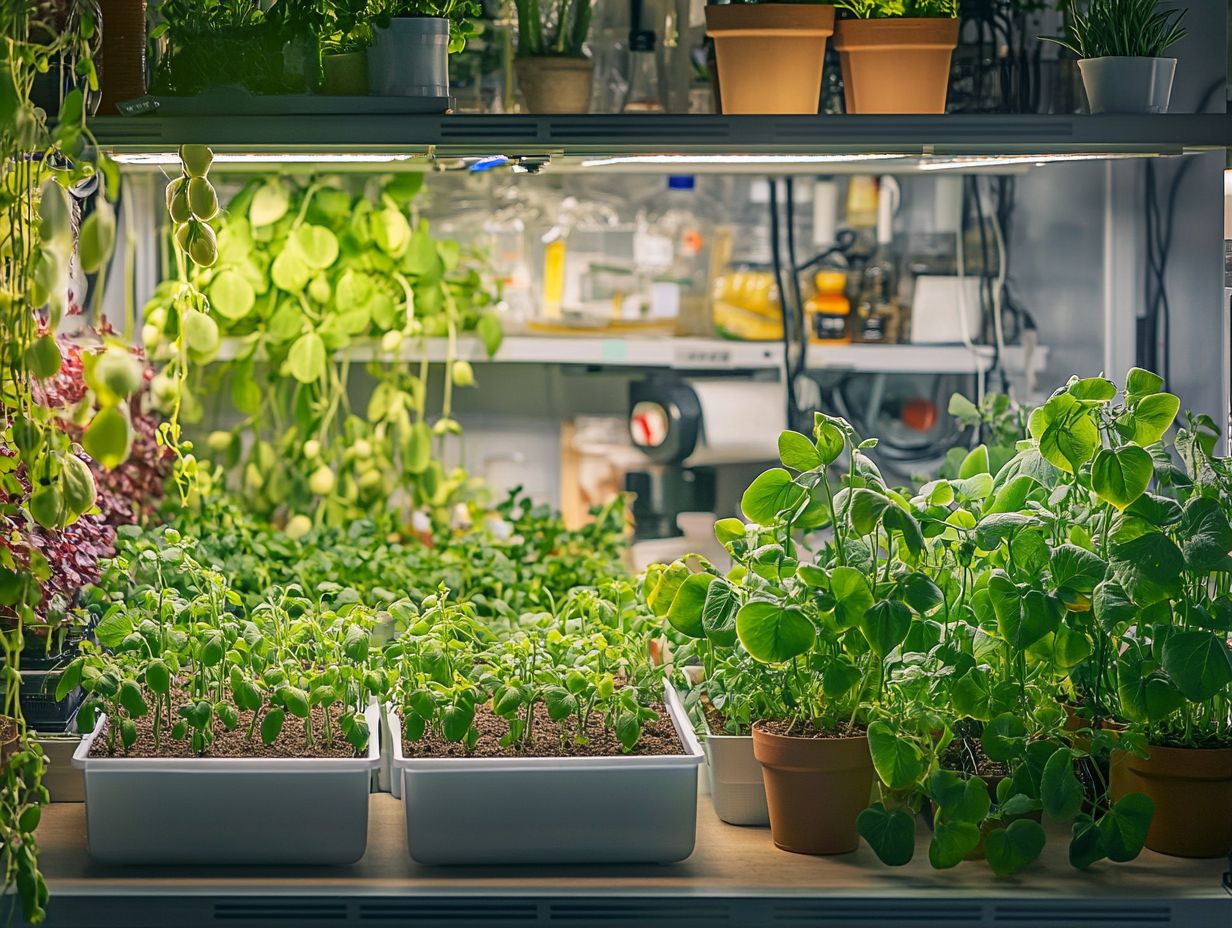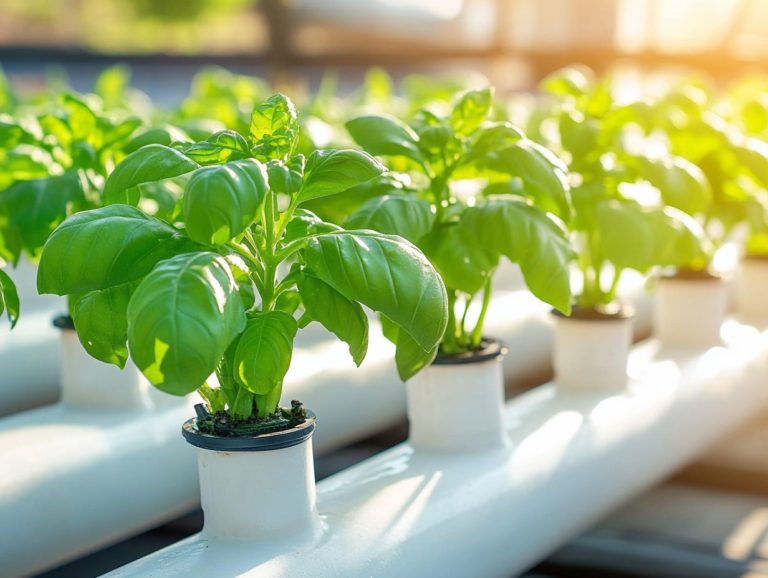“Best 10 Pea Varieties for Hydroponic Gardens”
If you aim to elevate your hydroponic garden, choosing the right pea varieties can significantly enhance your results. Delve into the top ten pea varieties that thrive in hydroponic systems, ranging from the crisp, refreshing Snow Peas to the rich and flavorful Alderman Peas.
Uncover the essence of hydroponic gardening, along with essential tips for beginners, common challenges you may face, and the impressive nutritional benefits of peas. Get ready to enjoy a flourishing garden brimming with delightful, fresh peas!
Contents
- Key Takeaways:
- 1. Snow Peas
- 2. Sugar Snap Peas
- 3. Green Arrow Peas
- 4. Cascadia Peas
- 5. Little Marvel Peas
- 6. Oregon Sugar Pod II Peas
- 7. Golden Sweet Peas
- 8. Alderman Peas
- 9. Wando Peas
- 10. Lincoln Peas
- What Are Hydroponic Gardens and Why Are They Beneficial?
- What Are the Key Factors to Consider When Choosing Pea Varieties for Hydroponic Gardens?
- How Can a Beginner Start Growing Peas in a Hydroponic Garden?
- What Are the Common Challenges When Growing Peas in a Hydroponic Garden?
- What Are the Nutritional Benefits of Peas and How Can They Be Incorporated into Meals?
- What Are Some Tips for Maintaining a Successful Hydroponic Pea Garden?
- Frequently Asked Questions
- 1. What are the best pea varieties for hydroponic gardens?
- 2. Why are these pea varieties ideal for hydroponic gardening?
- 3. Can I grow these pea varieties in a traditional garden as well?
- 4. What is the difference between these pea varieties and regular garden peas, such as snow peas?
- 5. How do I care for these pea varieties in a hydroponic system, alongside other plants?
- 6. Can I harvest these pea varieties more than once in a hydroponic system for continuous growth?
Key Takeaways:

- Snow peas, sugar snap peas, and green arrow peas are excellent for hydroponic gardens.
- Consider space, light, and water needs when choosing pea varieties.
- Beginners can grow peas by using nutrient solutions and proper lighting.
1. Snow Peas
Snow peas are a delightful addition to your hydroponic garden, bringing a unique balance of sweetness and crunch. These vibrant green edible pods catch the eye and are packed with vitamins and nutrients, making them a favorite among gardening enthusiasts, especially in urban settings like San Francisco.
When cultivated in a hydroponic system with plenty of nutrients, snow peas truly thrive. This offers you the incredible opportunity to grow fresh, delicious produce year-round. By focusing on optimal light, humidity levels, and maintaining the right pH range, you can enjoy a bountiful harvest from these low-maintenance plants.
To maximize your yield, aim to maintain a consistent temperature between 60 F and 70 F, as seeds germinate best under these conditions. Ensure your nutrient levels include sufficient nitrogen, phosphorus, and potassium; together, they support robust growth and pod development. Snow peas prefer well-drained growing mediums and respond favorably to regular watering, so keep lack of water at bay.
As these plants flourish, consider pairing them with companion plants like radishes or lettuce to maximize space and enhance overall plant health. With a quick growth cycle of approximately 60 days, snow peas are especially rewarding in a balanced hydroponic system, allowing you to reap multiple harvests throughout the year.
2. Sugar Snap Peas
Sugar snap peas are a delightful hybrid variety that fuses the sweetness of garden peas with the satisfying crunch of snow peas. They make an excellent choice for hydroponic gardeners seeking a flavorful and nutritious addition to their gardens.
With their crisp texture and delightful flavor, these peas flourish in well-drained, nutrient-rich environments and thrive in cooler temperatures for optimal growth. Utilizing hydroponic systems, particularly nutrient film techniques or deep water culture, creates the perfect conditions for sugar snap peas, granting them continuous access to moisture and essential nutrients. This method not only speeds up growth cycles but also maximizes your yield.
Packed with vitamins A, C, and K, along with folic acid and fiber, sugar snap peas enhance your meals while contributing positively to your health. When planting, sow the seeds about an inch deep, ensuring they are spaced adequately to accommodate their climbing nature. Using trellises for support will allow these charming plants to reach their full potential.
3. Green Arrow Peas
Green Arrow peas are known for their fast growth and high yields. They are a favorite for both beginner and experienced gardeners.
These peas thrive in temperatures between 60 and 70 degrees Fahrenheit. A nutrient-rich and well-aerated solution is essential for their growth.
Effective pest management is crucial for success. Protect your plants effectively by introducing beneficial insects like ladybugs or using organic deterrents. This way, you can avoid harmful chemicals.
To maximize yields, regularly monitor nutrient levels and pH balance. Careful pruning and support for climbing varieties can significantly enhance productivity.
4. Cascadia Peas
Cascadia peas are a standout choice for your garden. They are celebrated for their sweet flavor and compact growth.
These peas have a delightful taste that perfectly balances brightness with a crisp texture. They adapt well to various growing conditions, making them versatile.
Thriving in cooler climates, Cascadia peas flourish in well-draining, nutrient-rich solutions. Ensure your nutrient mix has a balanced supply of nitrogen and phosphorus for optimal growth and flavor.
For hydroponics enthusiasts, maintaining consistent moisture and providing adequate lighting is crucial. This diligence will help prevent stress and promote bountiful harvests.
5. Little Marvel Peas
Little Marvel peas are perfect for small spaces. They are prized for their low-maintenance nature and irresistibly sweet pods.
These compact plants thrive in cooler climates, making them ideal for sowing in early spring or late summer. They prefer well-drained soil rich in organic matter and appreciate consistent moisture throughout their growing period.
If you’re incorporating Little Marvel peas into your hydroponic garden, use a nutrient-rich solution while ensuring good airflow around the plants. This approach enhances flavor and simplifies maintenance, allowing novice gardeners to enjoy bountiful yields of tender, sweet peas.
6. Oregon Sugar Pod II Peas

Oregon Sugar Pod II peas are celebrated for their tender, flavorful edible pods. They are a splendid addition to your hydroponic garden if you’re aiming for high-quality yields.
To grow these peas successfully, pay attention to optimal planting conditions. Use nutrient-rich solutions and provide the right lighting to replicate their natural habitat.
Start by planting seeds in a well-aerated medium, ensuring they receive plenty of moisture without becoming waterlogged.
Once established, these peas flourish in a temperature range of 60 to 70 degrees Fahrenheit, which is vital for achieving peak flavor. As you approach the harvest stage, timing becomes crucial. Picking the pods while they re still young and crisp will elevate their sweetness and overall texture, ensuring each bite is delightful.
7. Golden Sweet Peas
Golden Sweet peas present an enticing twist on traditional varieties. Their vibrant yellow pods serve as both a stunning visual and a flavorful enhancement to your hydroponic garden.
These delightful legumes not only elevate the aesthetic appeal but also pack a nutritional punch. They are rich in vitamins A and C, folic acid, and protein. To achieve optimal growth, it s vital for you to understand their specific nutrient requirements, ensuring that your soil or hydroponic solution is abundant in potassium and phosphorus.
Golden Sweet peas thrive in well-drained soils and enjoy ample sunlight. They benefit from consistent watering. Implementing companion planting strategies can also boost their growth, making them a rewarding choice for those eager to maximize their harvest while promoting overall plant health.
8. Alderman Peas
Alderman peas, often referred to as Tall Telephone peas, are a gem in the world of hydroponic gardening. Their remarkable growth rate and ability to yield generous quantities of sweet, tender pods make them a favorite among gardeners.
Their adaptability in hydroponic systems positions them as an exceptional choice for both newcomers and seasoned gardeners. To support their vigorous growth, provide sturdy structures, like trellises, allowing the vines to climb and soak up sunlight. Managing nutrients effectively is essential; maintaining a balanced supply of nitrogen, phosphorus, and potassium will ensure your plants flourish.
Incorporating integrated pest management strategies will be key in controlling common pests. This allows your delicate plants to thrive throughout the growing season. By addressing these factors attentively, you ll set yourself up for a bountiful harvest of this delightful vegetable.
9. Wando Peas
Wando peas are a dependable and low-maintenance option for gardeners. They flourish effortlessly in hydroponic systems while offering sweet, flavorful pods that are ideal for fresh consumption or culinary creations.
These vibrant greens thrive best in well-drained, loamy soil with a pH level between 6.0 and 7.5, ensuring they absorb nutrients effectively. Providing them with at least six to eight hours of sunlight each day encourages robust growth and an abundance of blooms. Regular watering is key, as Wando peas prefer a consistently moist environment without becoming soggy.
To enjoy a bountiful harvest, watch for pests and diseases. Supporting your plants with trellises allows them to climb, ultimately leading to higher yields of those delicious pods you re eager to enjoy.
10. Lincoln Peas
Don’t miss out on growing Lincoln peas they’re a favorite for their rich flavor and versatility! This variety is exceptional for hydroponic gardeners eager to enhance both yields and taste.
Lincoln peas thrive in controlled environments and show remarkable resilience against pests and diseases an essential quality for anyone committed to sustainable gardening practices. Nutritionally, they are a powerhouse, brimming with essential vitamins, proteins, and fiber that contribute to your overall health while providing a delightful culinary experience.
This variety not only supports digestive health but is also packed with antioxidants that can enhance your immunity. When cultivating them hydroponically, it s vital to maintain optimal pH levels and the right nutrient concentrations, which refers to the amount of nutrients in the water. By doing so, you ensure that these peas flourish, delivering their finest flavor and nutritional profile.
What Are Hydroponic Gardens and Why Are They Beneficial?
Hydroponic gardens embody an innovative approach to food cultivation. They allow you to grow a diverse array of plants without the constraints of traditional soil. This technique optimizes water use and nutrient delivery, resulting in remarkable growth rates and superior flavor. It s no wonder many urban dwellers, like Teo Spengler in San Francisco, are embracing this efficient method to cultivate fresh, organic produce in limited spaces.
Hydroponic systems are particularly well-suited for leafy vegetables, garden herbs, and even fruits such as strawberries and cherry tomatoes. They provide a sustainable and low-maintenance gardening solution.
These systems come in various forms, including Nutrient Film Technique (NFT), which is a method where a thin film of nutrient solution flows over the plant roots, Deep Water Culture (DWC), and Aeroponics. Each offers unique advantages tailored to your specific gardening needs. By eliminating soil, hydroponics significantly reduces the risk of pests and diseases. This enables healthier plant growth while conserving water up to 90% less than traditional farming methods.
These benefits have transformed how individuals approach gardening and sparked a movement toward more sustainable urban agriculture. They demonstrate that even in compact spaces, thriving gardens can flourish, yielding bountiful harvests with minimal environmental impact.
What Are the Key Factors to Consider When Choosing Pea Varieties for Hydroponic Gardens?

When selecting pea varieties for your hydroponic garden, consider a few key factors that can make or break your gardening experience. Think about growth rate, flavor profile, and nutritional content. These elements are essential for ensuring you reap the rewards of your efforts.
Beyond these basics, pay attention to specific characteristics like disease resistance, yield potential, and adaptability to the hydroponic environment. For instance, choosing a variety with robust disease resistance can significantly enhance your crop’s health, reducing the risk of losing plants to pests or blights. Likewise, opting for a type with high yield potential can maximize your output, allowing you to produce more from a smaller space.
Ultimately, aligning these factors with your personal gardening goals whether you re after a diverse harvest or aiming for high-efficiency setups will lead to a more satisfying and successful journey in cultivating peas indoors.
How Can a Beginner Start Growing Peas in a Hydroponic Garden?
Starting a hydroponic garden with peas is not just rewarding; it s a thrilling adventure that brings fresh flavors to your table! To embark on this journey, it s vital to grasp the foundational aspects of hydroponic gardening. First, think about which hydroponic system best suits your space; your options include:
- Deep Water Culture
- Nutrient Film Technique
- An Aeroponic Setup
Once you’ve set up your system, choosing high-quality seeds is essential. Varieties like Sugar Snap or Snow Peas are excellent choices, known for their robust growth and delightful flavor. After planting, ensure you monitor light exposure and nutrient levels, providing the care your plants need to thrive.
If you encounter issues, such as yellow leaves or stunted growth, taking a closer look at the pH levels and nutrient concentrations can help you identify and resolve common challenges.
Ready to dive into hydroponics? Let s get started on creating your own thriving garden today!
What Are the Common Challenges When Growing Peas in a Hydroponic Garden?
Growing peas in a hydroponic garden comes with its own set of unique challenges. You ll need to manage nutrient levels, control pests, and create ideal growing conditions to foster healthy growth.
These factors are critical. Any imbalances can stunt development or even lead to crop loss. Nutrient imbalances often arise from over-fertilization or high water salinity. Quick testing of your water can prevent these issues and using balanced nutrient solutions specifically designed for legumes will help.
Keep a close eye on humidity levels, especially in closed systems. Excess moisture can attract mold and mildew. Utilizing dehumidifiers or ventilation systems can help maintain the right humidity for your plants.
Pest management is another essential focus. Employing organic pesticides and introducing natural predators can effectively keep harmful insects at bay, ensuring a healthy yield while supporting sustainable farming practices.
What Are the Nutritional Benefits of Peas and How Can They Be Incorporated into Meals?
Peas are a nutritional powerhouse, brimming with vitamin C and essential nutrients. They make a delightful addition to a variety of meals, elevating both flavor and health.
These little green gems are excellent sources of dietary fiber, folate, and protein. They contribute to heart health, improved digestion, and enhanced immunity. Packed with antioxidants, peas help combat oxidative stress, shielding your body from chronic diseases.
To reap these benefits, consider:
- Toss into salads for a burst of color and nutrition
- Blend into smoothies for a creamy, nutrient-rich texture
- Add to stir-fries and pastas for an extra layer of flavor
Try whipping up a comforting pea soup; it s an easy and delicious way to enjoy these legumes!
What Are Some Tips for Maintaining a Successful Hydroponic Pea Garden?
Maintaining a successful hydroponic pea garden demands keen attention to detail and a solid understanding of best practices. Ensure that your plants receive the optimal nutrients and care for vigorous growth and exceptional flavor.
To achieve this, monitor the balance of essential elements in your nutrient solutions. Guarantee that the water quality remains pristine and free of contaminants, and maintain the correct pH levels. Providing adequate light exposure whether through natural sunlight or grow lights is paramount for healthy photosynthesis.
Regularly inspect for pests and employ organic controls to dramatically reduce crop damage. By fine-tuning these elements, you can cultivate an ideal environment that fosters robust pea growth and generous harvests, transforming your gardening venture into a truly rewarding experience.
Frequently Asked Questions
1. What are the best pea varieties for hydroponic gardens?

Some of the best pea varieties for hydroponic gardens include Sugar Snap peas, Dwarf Grey Sugar peas, Little Marvel peas, Cascadia peas, Maestro peas, and Green Arrow peas.
2. Why are these pea varieties ideal for hydroponic gardening?
These pea varieties are ideal for hydroponic gardening because they are compact, do not require trellising, and have a shorter growing time, making them perfect for indoor gardening.
3. Can I grow these pea varieties in a traditional garden as well?
Yes, you can definitely grow these pea varieties in a traditional garden as they are also suitable for traditional gardening methods.
4. What is the difference between these pea varieties and regular garden peas, such as snow peas?
The main difference between these pea varieties and regular garden peas is their compact size and shorter growing time. Regular garden peas tend to be larger and require trellising for support.
5. How do I care for these pea varieties in a hydroponic system, alongside other plants?
To care for these pea varieties, ensure they have enough water, nutrients, and light.
Regularly check for pests and diseases, and provide support if needed.
6. Can I harvest these pea varieties more than once in a hydroponic system for continuous growth?
Absolutely! These pea varieties can thrive and produce multiple harvests.
As long as they are well taken care of and have sufficient nutrients and light, they will continue to flourish.






